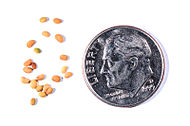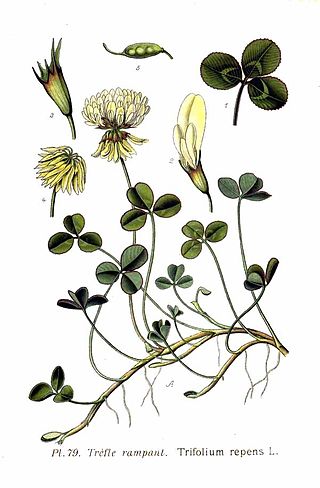
Clover, also called trefoil, are plants of the genus Trifolium, consisting of about 300 species of flowering plants in the legume family Fabaceae originating in Europe. The genus has a cosmopolitan distribution with highest diversity in the temperate Northern Hemisphere, but many species also occur in South America and Africa, including at high altitudes on mountains in the tropics. They are small annual, biennial, or short-lived perennial herbaceous plants, typically growing up to 30 centimetres (12 in) tall. The leaves are trifoliate, with stipules adnate to the leaf-stalk, and heads or dense spikes of small red, purple, white, or yellow flowers; the small, few-seeded pods are enclosed in the calyx. Other closely related genera often called clovers include Melilotus and Medicago.

Forage is a plant material eaten by grazing livestock. Historically, the term forage has meant only plants eaten by the animals directly as pasture, crop residue, or immature cereal crops, but it is also used more loosely to include similar plants cut for fodder and carried to the animals, especially as hay or silage.

Trifolium repens, the white clover, is a herbaceous perennial plant in the bean family Fabaceae. It is native to Europe, including the British Isles, and central Asia and is one of the most widely cultivated types of clover. It has been widely introduced worldwide as a forage crop, and is now also common in most grassy areas of North America, Australia and New Zealand. The species includes varieties often classed as small, intermediate and large, according to height, which reflects petiole length. The term 'white clover' is applied to the species in general, 'Dutch clover' is often applied to intermediate varieties, and 'ladino clover' is applied to large varieties.

Medicago truncatula, the barrelclover, strong-spined medick, barrel medic, or barrel medick, is a small annual legume native to the Mediterranean region that is used in genomic research. It is a low-growing, clover-like plant 10–60 centimetres (3.9–23.6 in) tall with trifoliate leaves. Each leaflet is rounded, 1–2 centimetres (0.39–0.79 in) long, often with a dark spot in the center. The flowers are yellow, produced singly or in a small inflorescence of two to five together; the fruit is a small, spiny pod.
Hop-clover is a common name for several different plants and may refer to:

Trifolium aureum, known by the various common names large hop trefoil, large trefoil, large hop clover, golden clover or hop clover, is a species of flowering plant native to much of Eurasia.
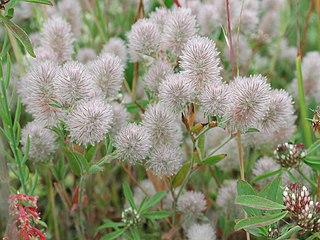
Trifolium arvense, commonly known as the hare's-foot clover, rabbitfoot clover, stone clover or oldfield clover, is a flowering plant in the bean family Fabaceae. This species of clover is native to most of Europe, excluding the Arctic zone, and western Asia, in plain or mid-mountain habitats up to 1,600 metres (5,200 ft) altitude. It grows in dry sandy soils, both acidic and alkaline, soil with dry-mesic conditions and is typically found at the edge of fields, in wastelands, at the side of roads, on sand dunes, and opportunistically in vineyards and orchards when they are not irrigated.

Trifolium campestre, commonly known as hop trefoil, field clover and low hop clover, is a species of flowering plant native to Europe and western Asia, growing in dry, sandy grassland habitats, fields, woodland margins, roadsides, wastelands and cultivated land. The species name campestre means "of the fields".

Melilotus officinalis, known as sweet yellow clover, yellow melilot, ribbed melilot and common melilot, is a species of legume native to Eurasia and introduced in North America, Africa, and Australia.

Melilotus albus, known as honey clover, white melilot (UK), Bokhara clover (Australia), white sweetclover (US), and sweet clover, is a nitrogen-fixing legume in the family Fabaceae. Melilotus albus is considered a valuable honey plant and source of nectar and is often grown for forage. Its characteristic sweet odor, intensified by drying, is derived from coumarin.

Trifolium incarnatum, known as crimson clover or Italian clover, is a species of short-growing flowering plant in the family Fabaceae, native to most of Europe. It has been introduced to other areas, including the United States and Japan.
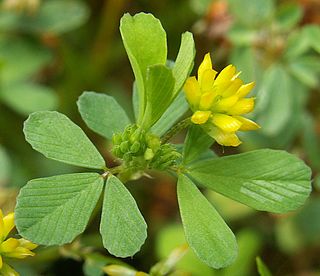
Trifolium dubium, the lesser trefoil, suckling clover, little hop clover or lesser hop trefoil, is a flowering plant in the pea and clover family Fabaceae. This species is generally accepted as the primary plant to represent the traditional Irish shamrock.

Medicago polymorpha is a plant species of the genus Medicago. It is native to the Mediterranean basin but is found throughout the world. It forms a symbiotic relationship with the bacterium Sinorhizobium medicae, which is capable of nitrogen fixation. Common names include California burclover, toothed bur clover, toothed medick and burr medic.
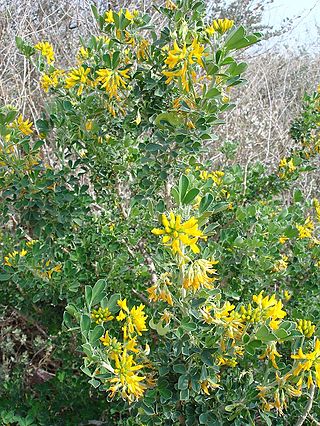
Medicago arborea is a flowering plant species in the pea and bean family Fabaceae. Common names include moon trefoil, shrub medick, alfalfa arborea, and tree medick. It is found throughout Europe and especially in the Mediterranean basin, primarily on rocky shores among shrubby vegetation. It forms a symbiotic relationship with the bacterium Sinorhizobium meliloti, which is capable of nitrogen fixation. It is the only member of the genus Medicago which is used as an ornamental. M. arborea is sometimes misidentified as Cytisus, which it resembles.

Medicago orbicularis is a plant species found throughout the Mediterranean basin and along the European Black Sea coast. It forms a symbiotic relationship with the bacterium Sinorhizobium medicae, which is capable of nitrogen fixation. Common names include blackdisk medick, button clover, button medick, and round-fruited medick.

Melilotus indicus, sometimes incorrectly written Melilotus indica, is a yellow-flowered herb native to northern Africa, Europe and Asia, but naturalized throughout the rest of the world.

The tribe Trifolieae is one of the subdivisions of the plant family Fabaceae. It is included within the inverted repeat-lacking clade (IRLC). All of the members of this tribe are trifoliate.
Phyllonorycter medicaginella is a moth of the family Gracillariidae. It is found from Denmark and Poland to Belgium, the Alps, Bulgaria and Ukraine.

Clavibacter insidiosus is a species of Clavibacter. It causes bacterial wilt, with its most notable host being Medicago sativa (alfalfa). Other species in the Medicago genus are also known to be hosts such as Medicago falcata. Additionally, Lotus corniculatus, Melilotus alba, Onobrychis viciifolia, and Trifolium sp. are known hosts.






